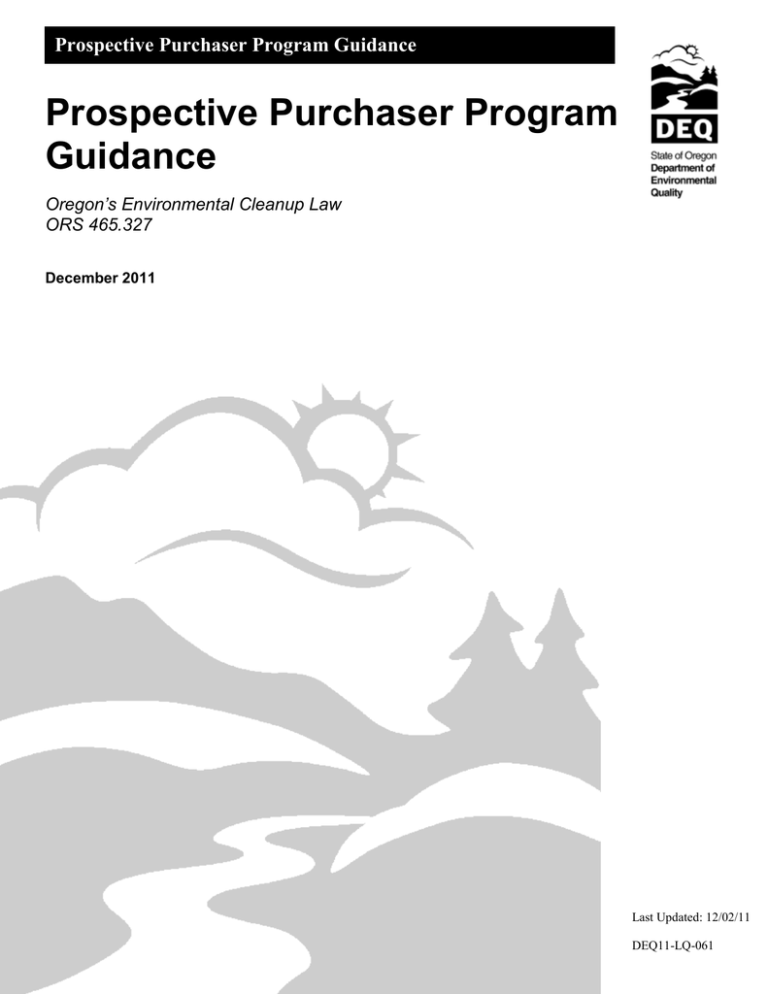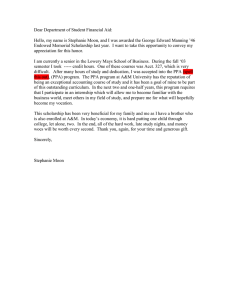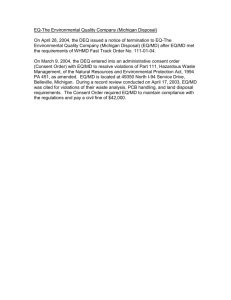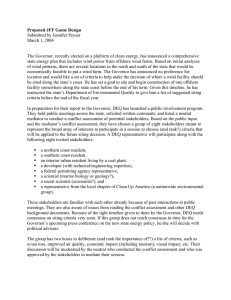Prospective Purchaser Program Guidance
advertisement

Prospective Purchaser Program Guidance Prospective Purchaser Program Guidance Oregon’s Environmental Cleanup Law ORS 465.327 December 2011 Last Updated: 12/02/11 DEQ11-LQ-061 This report prepared by: Land Quality Division Environmental Cleanup Program Oregon Department of Environmental Quality 811 SW 6th Avenue Portland, OR 97204 1-800-452-4011 www.oregon.gov/deq ii ii Prospective Purchaser Program Guidance ii I. Disclaimer DEQ reserves the right and the discretion to approve or disapprove Prospective Purchaser Agreements. This document provides information and technical assistance to the public and DEQ employees about DEQ’s cleanup program. This information should be interpreted and used in a manner fully consistent with the state’s environmental cleanup laws and implementing rules. This document does not constitute rulemaking by the Oregon Environmental Quality Commission and may not be relied on to create a right or benefit, substantive or procedural, enforceable at law or in equity, by any person, including DEQ employees. DEQ may take action at variance with this guidance. II. Approval This guidance document has been approved for use by the Department of Environmental Quality Land Quality Division. ____[Signed copy on file with DEQ]_______ Wendy Wiles, Division Administrator Oregon Department of Environmental Quality _ 12-08-2011___ Date DEQ11-LQ-061 iii iii Prospective Purchaser Program Guidance iii Table of Contents I. Disclaimer ....................................................................................................... ii II. Approval ......................................................................................................... ii 1. Introduction.................................................................................................... 1 1.1 Purpose ....................................................................................................... 1 1.2 Program Overview: What is a “Prospective Purchaser Agreement”?........ 1 2. Qualifying Criteria ........................................................................................ 2 2.1 Qualifying Criteria ..................................................................................... 2 2.2 Substantial Public Benefit .......................................................................... 2 3. Additional Factors Affecting PPA Negotiations ......................................... 4 Amount of Information Available About Environmental Contamination ........................................................................................ 4 3.2 Performance-Based Commitments to Cleanup Preferred .......................... 4 3.3 Cleanup Leading to Site Closure Preferred (No Further Action determination) ........................................................................................ 4 3.4 Long-term Obligations and Restrictions on Use ........................................ 5 3.5 Financial Viability ...................................................................................... 5 3.6 Land Use .................................................................................................... 5 3.7 Consultation with Other State Agencies .................................................... 5 3.8 Recording Requirements ............................................................................ 5 3.9 Statutorily Required Terms of the PPA ..................................................... 5 3.10 Additional Terms........................................................................................ 6 3.1 4. Forms and Effect of PPAs ............................................................................. 7 4.1 Administrative Agreement PPA ................................................................. 7 4.2 Consent Order PPA .................................................................................... 7 4.3 Consent Judgment PPA .............................................................................. 7 4.4 CERCLA (Federal Regulations) Liability ................................................. 7 5. Public Participation ....................................................................................... 8 6. Application and Review and Negotiation Costs .......................................... 9 7. 7.1 Process for Review and Approval of PPAs ................................................ 10 Typical Steps in PPA Review and Approval ........................................... 10 8. Performing Obligations Under the PPA .................................................... 12 9. Additional Information ............................................................................... 12 Oregon Department of Environmental Quality DEQ11-LQ-061 1 1 Prospective Purchaser Program Guidance 1 1. Introduction 1.1 Purpose This document provides an overview of Oregon DEQ’s Prospective Purchaser Program and explains the process for applying for and executing a Prospective Purchaser Agreement. This guidance replaces prior Prospective Purchaser Program Guidance dated Nov. 20,1997. 1.2 Program Overview: What is a “Prospective Purchaser Agreement”? The term Prospective Purchaser Agreement describes an agreement (referenced to Oregon Revised Statute (ORS) 465.327) between a prospective purchaser of contaminated property and the Oregon Department of Environmental Quality. Individuals or entities who may negotiate a PPA with DEQ are not limited to prospective “purchasers” per se, but may also include prospective holders of other interests in a property, such as a prospective lessee. PPAs are designed to facilitate cleanup and productive reuse of contaminated property. Existing contamination is often an obstacle to the transfer and redevelopment of property. PPAs provide certainty to purchasers about the extent of their cleanup obligations and liability for existing contamination and thereby encourage the transfer, cleanup and reuse of contaminated property. PPAs can benefit the purchaser, community, local jurisdictions, and the state in many ways. Benefits of a PPA may include: • A facility is cleaned up or closer to being cleaned up because of contributions from the purchaser, thereby enhancing protection of human health and the environment. • A property is returned to productive use and returned to the tax base. • Jobs are often created and blight is addressed. • Neither state nor local government is burdened with all of a facility’s cleanup costs. • It may be easier for the purchaser to acquire financing with cleanup actions and liability protections addressed in the PPA. • A property will be clean, and liability protections in the PPA run with the land (i.e., are transferred to subsequent purchasers). Oregon Department of Environmental Quality DEQ11-LQ-061 2 2 Prospective Purchaser Program Guidance 2 2. Qualifying Criteria 2.1 Qualifying Criteria As provided in Oregon law (ORS 465.327), DEQ may approve PPAs “to facilitate cleanup and reuse of contaminated property” if all of the following criteria are met: 1) The prospective purchaser is not currently liable under any of the three following statutory authorities for an existing release of hazardous substances at the property to be purchased: ORS 465.255; ORS 466.640; or ORS 468B. 2) Contamination exists and removal or remedial action is necessary at the property under ORS 465. 3) The proposed use of the property will not contribute to or exacerbate existing contamination, increase health risks or interfere with necessary remedial action measures at the facility1. 4) A substantial public benefit [described below] will result from the PPA. While the decision to enter into a PPA is solely within DEQ’s discretion, DEQ cannot enter into a PPA if any one of the conditions listed above cannot be satisfied. 2.2 Substantial Public Benefit Of the criteria listed above, determining if a PPA would provide a “substantial public benefit” is perhaps the key to approval. Substantial public benefit will be a site-specific question because each property presents a unique set of cleanup and redevelopment issues. DEQ evaluates each property and the proposed public benefits on a case-by-case basis. The statute describes four types of substantial public benefits acceptable for a PPA, listed below, with examples for illustrative purposes: 1) Generation of substantial funding or other resources for remedial measures at the facility. Example 1A: A portion of sale proceeds from the property transaction will be dedicated to remedial measures, in an amount that DEQ deems sufficient to meaningfully facilitate necessary remedial measures. Example 1B: The current owner is conducting the cleanup but has insufficient resources to complete the work. The purchaser agrees to supplement the current owner’s work to significantly advance or complete remedial action at the facility. 1 This guidance uses the term “facility” consistent with ORS 465.200(13), to reflect the extent of contamination requiring environmental investigation or cleanup. The “facility” might be larger than but encompass all or part of the “property” subject to a PPA transaction. Oregon Department of Environmental Quality DEQ11-LQ-061 3 3 Prospective Purchaser Program Guidance 3 DEQ expects that – regardless of a development’s end use – that sale proceeds will be dedicated to cleanup of the facility as necessary to complete the cleanup. If a PPA would result in less than 100 percent cleanup, buyers and sellers should expect that DEQ will want to know the value of the transaction and that DEQ will compare this transaction value to the cost to fully clean up the facility. DEQ will not enter into PPAs that do not fully address cleanup needs and thereby might provide a “windfall” to a liable seller. 2) A commitment to perform substantial remedial measures at the facility. Example 2: The prospective purchaser agrees to perform removal or remedial measures necessary to implement, advance or complete cleanup. Measures of this type may include, but are not limited to: soil removal, capping or treatment; groundwater treatment; long term monitoring; and restrictions on property use. 3) Productive reuse of vacant or abandoned industrial or commercial property. Example 3: The property has been out of use or underused for a long time and the purchaser agrees to develop the property so that it returns to productive use, creates jobs, and/or becomes aesthetically pleasing. 4) Development of the property by a government entity or nonprofit organization to address an important public purpose. Example 4: The intended land use is for bridges, roads, boat access, open space, public recreation, public housing, public schools, public safety, community centers and similar non-profit public uses. The city and county in which the proposed use will be located support the development, and the transaction will help remediate existing contamination. The above listing of substantial public benefit types is not exhaustive. Any number of factors at a particular property can be combined to result in a substantial public benefit. DEQ encourages parties to be creative. Example 5: A prospective purchaser proposes an innovative pollutionprevention or toxics-use-reduction approach for a yet-to-be constructed operation, for the businesses to be operated at the property, or for industry in general. The approach must exceed currently established local, state and federal environmental requirements and must offer the potential for significant environmental benefits that otherwise would not be achieved. Oregon Department of Environmental Quality DEQ11-LQ-061 4 4 Prospective Purchaser Program Guidance 4 3. Additional Factors Affecting PPA Negotiations 3.1 Amount of Information Available About Environmental Contamination Except in extraordinary circumstances, DEQ will not enter into a PPA until contamination at the facility has been fully investigated (including, as applicable, any offsite migration from the property). While DEQ encourages buyers to contact DEQ as soon as they begin thinking about the PPA program, the nature and extent of contamination at the facility must be fully defined before the important terms of a PPA can be developed. DEQ and the buyer both need to understand the full extent of contamination at the facility so that DEQ can identify necessary removal or remedial actions. The extent of contamination and extent/cost of cleanup actions are key factors influencing the transaction and the PPA. In most cases, buyers and sellers negotiate who will perform the site investigation. DEQ strongly encourages the party performing the investigation to do so under DEQ oversight, both to make sure the investigation is done correctly and to begin scoping cleanup actions. Failure to involve DEQ early in the process may cause delays in a transaction, especially if DEQ determines that additional site investigation is required. DEQ strives for an efficient and timely PPA process, and prospective purchasers should allow adequate time for full site investigation in their transaction planning and purchase agreements. Standard due-diligence periods of 60 or 90 days are almost always inadequate to complete site investigation of contaminated properties. Similarly, anticipated closing dates should be set with an understanding of the time required to investigate a site, develop a cleanup plan, and complete all public notice and comment requirements. 3.2 Performance-Based Commitments to Cleanup Preferred DEQ strongly prefers defining the purchaser’s cleanup contribution in terms of performance of specific actions, rather than dollars. In most cases, a Record of Decision (ROD) will describe cleanup necessary at the facility, and the purchaser’s cleanup duties will be described in a Scope of Work incorporated into the PPA. Where the prospective purchaser will be performing cleanup actions, the purchaser will usually engage an environmental cleanup contractor to assist in the transaction by coordinating with DEQ’s cleanup staff, performing investigations, developing and providing cost estimates for cleanup actions, etc. Generally, DEQ does not provide cleanup cost estimates. 3.3 Cleanup Leading to Site Closure Preferred (No Further Action determination) DEQ prefers PPAs that lead to full cleanup of the facility, because it is in the best interests of all concerned: the buyer, seller, state, local jurisdictions and neighbors. If the transaction cannot provide enough resources for a full cleanup, DEQ has experience working with a variety of funding partners to bring additional funds to the cleanup. Oregon Department of Environmental Quality DEQ11-LQ-061 5 5 Prospective Purchaser Program Guidance 5 3.4 Long-term Obligations and Restrictions on Use Buyers should understand that, under Oregon’s risk-based cleanup approach, remedies for many sites include “institutional controls.” Buyers may be required to enter into a separate agreement with DEQ, called an “Easement and Equitable Servitudes” (E&ES) in which the buyer will, for example, agree to: maintain a cap over contaminated soil; maintain a building ventilation system; restrict use of groundwater; restrict use of the property to industrial uses; and similar measures. These restrictions run with the land and bind future owners. At some properties, DEQ may use an Environmental Hazard Notice as an alternative to an E&ES. 3.5 Financial Viability DEQ may ask the purchaser to demonstrate that it is financially capable of fulfilling its PPA obligations. 3.6 Land Use Oregon statute requires DEQ to consult with affected land-use planning jurisdictions and consider reasonably anticipated future land uses at a facility and surrounding properties. Early in the negotiation process, DEQ will require the prospective purchaser to consult with the appropriate jurisdiction to determine whether the purchaser’s proposed use is consistent with land-use plans for the area and to provide DEQ with a record of that consultation. 3.7 Consultation with Other State Agencies When contamination from a property affects lands owned by the state of Oregon (primarily submerged or submersible lands), DEQ will consult with the Oregon Department of State Lands about a proposed PPA. Similarly, if past contamination may have damaged natural resources, DEQ will consult with the Oregon Department of Fish and Wildlife about the proposed PPA, especially if the PPA includes a release from the state of Oregon for natural resource damage claims. DEQ will coordinate with the Oregon Department of Transportation or local governments when contamination extends into a public right-of-way. 3.8 Recording Requirements PPAs must be recorded in the real property records of the county where the property is located. The prospective purchaser is responsible for properly recording the documents in the appropriate office and providing DEQ with evidence of such recording. PPAs “run with the land,” meaning that subsequent owners are both bound by, and benefit from, terms of the PPA. 3.9 Statutorily Required Terms of the PPA Oregon law provides that, at a minimum, PPAs will contain these specific terms: • The purchaser commits to undertake measures constituting a substantial public benefit. • Remedial measures required under the PPA must be performed under DEQ’s oversight. (The purchaser must enter the appropriate DEQ cleanup program and is responsible for paying for DEQ oversight costs.) Oregon Department of Environmental Quality DEQ11-LQ-061 6 6 Prospective Purchaser Program Guidance • The purchaser must waive any claim or cause of action against the state of Oregon arising from contamination at the facility existing as of the date of ownership or operation of the facility. • The purchaser must grant an irrevocable right of entry to DEQ and its authorized representatives for the purposes of the agreement or for remedial measures. • An express reservation of rights as to an entity not a party to the agreement. • The PPA must include a legal description of the property. 6 3.10 Additional Terms DEQ has the discretion to include additional terms that are necessary. Standard language for the different forms of PPAs (see below) is available on DEQ’s PPA web page (http://www.deq.state.or.us/lq/cu/ppa.htm) or by request to DEQ. Many terms of a PPA are standard and not subject to negotiation, making the process more efficient for the prospective purchaser and DEQ. Oregon Department of Environmental Quality DEQ11-LQ-061 7 7 Prospective Purchaser Program Guidance 7 4. Forms and Effect of PPAs A PPA is a legally binding agreement between DEQ and a prospective purchaser of contaminated property. PPAs may be executed in three different forms: as an administrative Agreement, as an administrative Consent Order, or as a judicial Consent Judgment. The form of each agreement is available on DEQ’s Prospective Purchaser web page or by contacting DEQ. DEQ will consult with the prospective purchaser and its attorney regarding the form of agreement that would be most appropriate for a particular property. However, DEQ strongly advises every prospective purchaser who desires to enter into a PPA to seek advice and representation from a qualified attorney. DEQ cannot and will not provide legal advice to prospective purchasers. 4.1 Administrative Agreement PPA An Administrative Agreement PPA defines and limits the extent of a purchaser’s liability to the state of Oregon for environmental cleanup under various state laws (ORS 465.200 et seq., 466.640, and 468B.310). The protection provided by the PPA is a “release of liability,” which is a promise from the state not to require the purchaser to perform or pay for environmental cleanup at the facility of any contamination existing at the time of property purchase, provided that the purchaser fulfills all obligations under the PPA. The PPA does not provide liability protection as to any additional contamination that may occur after property purchase. An Administrative Agreement PPA also does not protect the purchaser from potential legal actions by third parties under state law against the purchaser with respect to the contamination. 4.2 Consent Order PPA A Consent Order PPA provides a release from liability to the state of Oregon and also provides protection from actions by third parties that might be brought under the following state laws: 1) claims under ORS 465.255; 2) claims for contribution under ORS 465.257; and 3) claims under ORS 466.640 and ORS 468B.310 related to spills. 4.3 Consent Judgment PPA A Consent Judgment PPA provides the same liability protections as a Consent Order PPA, in the form of a covenant not to sue and a liability release. The difference is that DEQ executes Consent Orders, while the circuit court in the county where the property is located executes Consent Judgments. 4.4 CERCLA (Federal Regulations) Liability None of the PPAs provide liability protection from the federal government (U.S. EPA) for claims under the federal cleanup law (CERCLA—Comprehensive Environmental Response, Compensation and Liability Act). Prospective purchasers should consult with an attorney about liability management under federal law, including the CERCLA “bona fide prospective purchaser” provision. DEQ intends that all PPAs will be “settlements” for purposes of third-party contribution protection under Section 113(f)(2) of CERCLA. Oregon Department of Environmental Quality DEQ11-LQ-061 8 8 Prospective Purchaser Program Guidance 8 5. Public Participation The degree of required public participation varies with the form of the PPA. For Administrative Agreement PPAs, DEQ notifies the public of the PPA after it has been finalized. This notice is published in one or more newspapers in the community of the subject property. The purchaser pays for the cost for this notice publication. While there is no legal requirement for public notice before an Administrative Agreement PPA is executed, there may be instances where public involvement is advisable. DEQ will make a case-by-case determination about the need for taking additional actions to ensure meaningful community involvement, and these additional actions may lengthen the time required to complete a PPA. Consent Order and Consent Judgment PPAs are executed only after completion of the public notice and comment process set out in ORS 465.320, and DEQ’s consideration of public comments. Requirements include publication of an opportunity to comment on the proposed PPA in the Secretary of State’s Bulletin and a local newspaper, with a required 30-day public comment period. A public meeting may be required or advisable for some PPAs. In planning transaction timelines, prospective purchasers should take into account the additional time required for the notice and comment process of Consent Order and Consent Judgment PPAs. Entering into a PPA does not alter requirements for public involvement during the cleanup process. Public notice for remedy selection will be followed as required by Oregon law. Oregon Department of Environmental Quality DEQ11-LQ-061 9 9 Prospective Purchaser Program Guidance 9 6. Application and Review and Negotiation Costs A prospective purchaser’s first step is to consult with DEQ’s Prospective Purchaser Program coordinator about the proposed project to determine whether the property and proposed benefits meet minimum PPA qualifications. There is no cost for this initial consultation. Once the prospective purchaser and DEQ determine that it is appropriate to begin discussing PPA details, the prospective purchaser must apply to the program by submitting the following: 1) a completed Prospective Purchaser Application (attached); 2) a signed Cost Recovery Letter Agreement (attached); and 3) a $2,500 deposit, payable to “DEQ, Hazardous Substance Remedial Action Fund.” DEQ staff involved in negotiating PPA terms will charge their time against the purchaser’s deposit. Staff involved in negotiations will include, at a minimum, the program coordinator and a technical staff person from the DEQ regional office where the property is located. Depending on the PPA’s complexity, DEQ managers and the Oregon Attorney General’s office may also be asked to review terms of the PPA. More complex PPAs will typically take longer to complete because of additional review required. When negotiations are complete, DEQ will either return any unspent funds to the applicant or transfer them to their cleanup account, if the purchaser is performing cleanup activities at the facility as part of the PPA. If the deposit is depleted, the Cost Recovery Letter Agreement authorizes DEQ to invoice the applicant monthly for expenditures above the $2,500 deposit. Oregon Department of Environmental Quality DEQ11-LQ-061 10 10 Prospective Purchaser Program Guidance 10 7. Process for Review and Approval of PPAs The Land Quality Division, at DEQ’s headquarters office in Portland, coordinates negotiation, review and approval of PPAs, in consultation with appropriate regional or headquarters staff. Note that the time required to execute a final PPA varies widely, depending on project specifics and complexity, amount of technical data to be reviewed, status of site investigation and remedy selection, and availability of DEQ staff. In most cases, PPA documents themselves can be prepared relatively quickly. However, cleanup process requirements, including site investigation and remedy selection, will take longer. 7.1 Typical Steps in PPA Review and Approval 1) DEQ’s program coordinator discusses the PPA process with potential applicants and provides them with the program packet. The discussion should include an evaluation of whether the proposed project meets minimum PPA requirements. This may require an internal inquiry into file information about the facility and property. It may also be helpful to have the likely DEQ project manager attend the initial meeting, to address technical concerns or questions. If the purchaser’s proposal and property is a good candidate for a PPA, DEQ’s program coordinator will encourage the purchaser to submit a formal application. 2) DEQ’s program coordinator reviews the submitted Application and Cost Recovery Letter Agreement to verify that it is complete, accurate to the best of staff’s knowledge, and includes a legal description of the property. 3) DEQ’s program coordinator processes the deposit and Cost Recovery Letter Agreement, if applicable, and opens a project account for the PPA. 4) DEQ’s program coordinator meets with applicant and DEQ project manager to discuss the facility, including known or suspected contamination, the degree to which the facility has been investigated and the need for any additional investigation, whether removal or remedial actions have been selected or approved by DEQ, and proposed redevelopment plans for the property. 5) Based on initial meetings and DEQ review of any facility documents, including Phase I site assessment and other reports, DEQ’s program coordinator discusses with the applicant the steps and process required to develop and complete a PPA. 6) Prospective purchaser (or seller) completes all necessary investigation and works with DEQ to develop removal and remedial actions for the facility. In most cases the purchaser will perform the removal or remedial actions after the PPA is executed and the property transaction closes. Oregon Department of Environmental Quality DEQ11-LQ-061 11 11 Prospective Purchaser Program Guidance 7) Prospective purchaser consults with the appropriate land-use jurisdiction about purchaser’s proposed use of the property, as compared to current and future land-use plans for the area. 8) DEQ and prospective purchaser agree on terms of the PPA. 9) DEQ drafts the PPA. In most cases, DEQ will negotiate and draft Administrative Agreement and Consent Order PPAs. However, DEQ may involve the state Attorney General’s office as needed for PPAs that: 1) are complex; or 2) might affect other state agencies; or 3) require advice or assistance regarding unusual legal issues. Because Consent Judgment PPAs must be filed in circuit court, the Attorney General’s office is always involved in this type of PPA. 11 10) DEQ’s program coordinator sends a draft PPA to the purchaser for review and schedules any necessary meetings for further negotiation. 11) As necessary and appropriate, DEQ staff complete the public notice and comment period. For agreements requiring public notice and opportunity for comment, DEQ staff prepare a memorandum or other agency record showing consideration of any public comments and the DEQ program coordinator’s recommendation about the PPA. 12) For Administrative Agreement and Consent Order PPAs, the purchaser and DEQ’s Land Quality Division administrator sign two originals. The date of the last signature becomes the PPA execution date. One fully executed PPA is provided to the purchaser and the other is retained in DEQ’s central PPA files. A copy of the PPA is also provided to the DEQ project manager for the facility. DEQ will provide the prospective purchaser with a draft Public Notice of Agreement, to be sent to local publications for public notification purposes and identify other appropriate local or statewide venues or publications for notification (e.g., League of Oregon Cities newsletter). 13) For Consent Judgment PPAs, the purchaser and DEQ sign the Consent Judgment. Then the Attorney General’s office files the Consent Judgment and a complaint (for jurisdictional purposes) with the circuit court. Once the Consent Judgment is lodged by the court (the PPA execution date), DEQ provides a copy to the purchaser. 14) DEQ’s program coordinator forwards project information to the appropriate regional Environmental Cleanup Site Information (ECSI) Coordinator, for entry into the ECSI database. 15) The purchaser records the PPA. (As mentioned previously, PPAs must be recorded in the real property records of the county in which the property is located. The purchaser is responsible for properly recording the documents in the appropriate office and providing DEQ with evidence of such recording.) Oregon Department of Environmental Quality DEQ11-LQ-061 12 12 Prospective Purchaser Program Guidance 12 8. Performing Obligations Under the PPA In most cases, after execution of the PPA and closing of the property transaction, the purchaser will perform cleanup actions under the PPA. Those actions will be completed under the oversight of a DEQ project manager, usually in either the Voluntary Cleanup or Leaking Underground Storage Tank programs. When the purchaser has completed PPA obligations, DEQ will issue a letter (for Administrative PPAs) or a Certificate of Completion (for Consent Order and Consent Judgment PPAs) stating that the prospective purchaser has complied with all PPA obligations. DEQ may also make a No Further Action (NFA) determination, provided the property meets requirements for an NFA. That decision usually will be made separately from a letter or Certificate of Completion. 9. Additional Information To obtain further information about the program, visit DEQ’s PPA web page at http://www.deq.state.or.us/lq/cu/ppa.htm, which includes contact information for the PPA program coordinator. Oregon Department of Environmental Quality DEQ11-LQ-061




